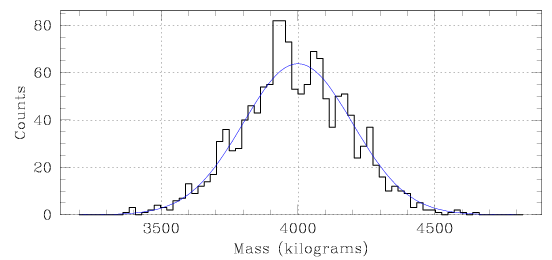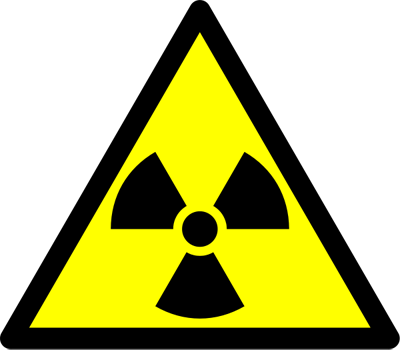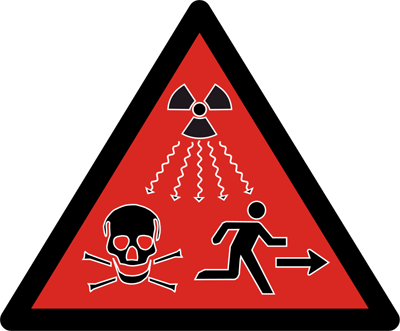
Summary of results:
Maria Mitchell's score on this quiz was 100%.
#1. If a planet has a year shorter than one Earth year, at what radius does it orbit the Sun?
#2. Does Kepler's Third Law depend on the orbital period of the planet in question?
#3. What is the mean value for the sample of masses shown in the histogram below, in units of kilograms?
#4. The two signs shown below indicate the presence of radioactive material. The more modern sign on the right carries a symmetric trefoil with energy streaming away from it to indicate .
#5. If Terrestrial planets are like rocks, then Jovian planets are like .
Elapsed Time: 5.18 minutes
#1.
If a planet has a year shorter than one Earth year, at what radius does it orbit the Sun? Remember that the Earth has an orbital radius of 1 A.U., and takes one Earth year to go once around the Sun.| less than one A.U. |
| one A.U. |
| more than one A.U. |
| We need more information to answer this question. |
We use Kepler's third law to relate the period P and the radius R of a planet about the Sun. We know that the square of the period is proportional to the cube of the radius.


We also know that the Earth has an orbital radius of 1 A.U., and takes one Earth year to go once around the Sun. Given these values, we can determine the orbital radius of any other planet once we know its rotational period. The radius, in Earth orbital radii, is equal to the period, in Earth years, raised to the power of two-thirds.



#2.
Does Kepler's Third Law depend on the orbital period of the planet in question?| Yes | No |
Kepler's Law connects the orbital radius, the distance from the Sun, for a planet with the length of its year (the amount of time it takes to go once around the Sun). In Earth units, where for the Earth the period P is one and the orbital radius R is one,

The key to Kepler's Third Law is that the Sun's gravitational field gets stronger and stronger as one approaches closer and closer to it. The inner planets must thus travel the fastest, using the energy of their kinetic motion (their speed) to stay just out of reach of the Sun.


#3.
What is the mean value for the sample of masses shown in the histogram below, in units of kilograms? A smoothly varying, blue normal curve has been added to the data, to help guide your eyes.
A histogram is a plot showing how many measured values of a given quantity occur within bins. As the mean value is the average of the measured values, it appears in the middle of the plot along the x-axis, neither too far to the left (with the smallest values) nor too far to the right (with the largest values). It is the central, or average, value, and corresponds to the peak of the normal curve.


#4.
The two signs shown below indicate the presence of radioactive material. The more modern sign on the right carries a symmetric trefoil with energy streaming away from it to indicate . |
 |
| these items should be kept cool with a fan |
| radiation |
| you can stay warm by sitting here |
| if you can find the on switch, a shower will start |
Because many radioactive materials have long half-lives, storing them safely is a real challenge. We have attempted to create signs that rely on universal symbols and do not depend on a specific language, in order to make them as accessible as possible to as many people as possible for as long a period of time as possible. One goal is to be able to warn away people who might not have the technology or historical records to otherwise understand the dangers of radioactive materials.
Because strong radiation can damage cellular structure, and the damage is cumulative (it increases with extended exposure), it is important to label decay products so that future societies can comprehend the potential danger.
The trefoil symbol is deliberately symmetric, so that it will be easy to recognize no matter the orientation of the materials. (It won't confuse people if it is placed upside-down.)


#5.
If Terrestrial planets are like rocks, then Jovian planets are like .| large balls of cotton candy | bullets |
| larger rocks | shiny hubcaps |
The Jovian planets are both larger and less dense than the Terrestrial planets. Both types of planets are spherical (round).

